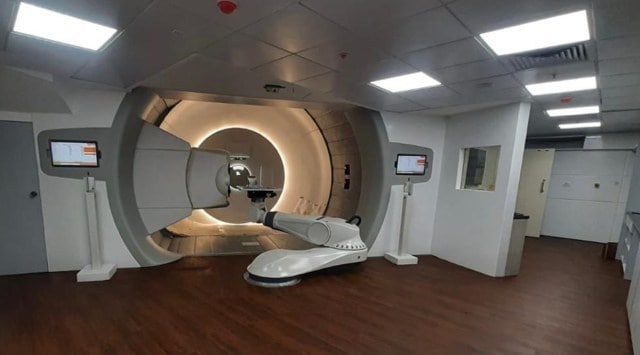Tata centre selects 5 kids for proton beam therapy for cancer
In India, the Apollo Proton Cancer Centre (APCC), a private centre in Chennai, was the first in India to start proton therapy in India where patients shell out between Rs 20 lakh and Rs 30 lakh for the entire course.
 The centre is expected to initiate proton beam therapy in the next 2-3 weeks. (Express Photo)
The centre is expected to initiate proton beam therapy in the next 2-3 weeks. (Express Photo) THE TATA Memorial Centre in Kharghar has selected the first five cancer patients—children up to the age of 12 years–for the world’s most sophisticated forms of cancer treatment as it is expected to initiate proton beam therapy in the next 2-3 weeks.
Proton therapy is a type of radiation therapy that uses protons rather than X-rays. It works by disrupting the tumour’s DNA and destroying tumour cells. It is more precise and less harmful. Tata Memorial Centre has become the first government facility in the country and one of the 100 centres world-wide to provide the cutting-edge radiation treatment. The 500-crore worth project is ready but waiting for the final green signal from the government’s Atomic Energy Regulatory Board.
“We are hoping to get the approval in the next 2-3 weeks. The treatment preparation of these five children will be done in 2-3 days. So once we get the nod, the very next day we can take the children for treatment,” said Dr Siddhartha Laskar, deputy director, academics and in-charge of the proton therapy at Tata Memorial Hospital, Parel.
Authorities at the hospital said that its radiology department has been getting daily queries regarding the treatment protocols for the therapy. But since it is not suitable to fight all cancers, after much consideration and screenings, the hospital decided to first start the treatment among paediatric patients and chose five children as of June 10, an official said. The children suffer from malignant pelvic bone tumours or Chondrosarcoma—the second most common form of bone cancer. It severely affects patient quality of life and is associated with low survival, high disability. Also, global studies have shown that conventional radiation weakens the pelvic bone structure and develops the risk of pelvic insufficiency fractures.
Dr Laskar explained that proton therapy helps to deliver the most energy at the targeted area, sparing nearby healthy tissues and minimising side effects compared with conventional radiation. “It has been proved most advantageous among children, esp-ecially in conditions where one needs high dosage of radiation like in bone cancer which has high resistance to radiation,” he said.
“With time, we will also use the therapy in areas that involve critical structures like in the brain surrounding the tumour. But at the start of the therapy, we want to focus on areas that are less invasive,” he added.
The cost of treatment with proton therapy in the US ranges between Rs 1 crore to Rs 1.5 crore. However, 40 percent of the patients will get the treatment at Advanced Centre for Treatment, Research and Education in Cancer (ACTREC), Kharghar at a subsidized rate, while the remaining 60 percent of the patients who belong to the economically weaker section could get free of cost treatment.
After getting selected for the therapy, the doctors have to perform complicated treatment preparations which takes around a week.
Dr Laskar stated that in the first stage, the patients are positioned in particular ways to acquire images through CT and MRI scanning. “The images help us to see the tumour from various angles. Using these scans, the radiation oncologist locates the tumour and uses a computer to map its exact shape and size. Following which, we put beams for stimulation to see the best ways to reach the tumour and the positions. Here, we practice the angles and the timings…once we decide on the best approach, we can start the treatment,” he said.
The foundation stone for the Tata proton facility was laid by former prime minister Manmohan Singh in 2014 in Haffkine compound next to TMC’s Parel hospital. However, due to space constraints, it was shifted to ACTREC Kharghar centre. In May this year, Prime Minister Narendra Modi virtually inaugurated it.
The TMC is the only hospital in the world to have three gantry machines that can rotate 360 degrees — uses a large magnet to foc-us the stream of protons into a thin beam. The machine has been imported from a company in Bel-gium that is a pioneer in particle therapy. A global tender was also floated for the selection process.
“We had mentioned a few specifications under which the company manufactured a particular proportion of the machine in India under Make in India initiative…the model that we have, is the most advanced one in the world,” said Dr Laskar.
In India, the Apollo Proton Cancer Centre (APCC), a private centre in Chennai, was the first in India to start proton therapy in India where patients shell out between Rs 20 lakh and Rs 30 lakh for the entire course.












